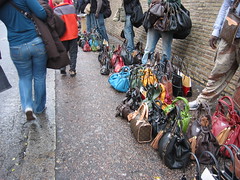Fake It ‘Til You Make It?
If you browse the site regularly in search of amazing additions to your wardrobe, you’ve undoubtedly noticed that there are a lot of items (usually accessories) that are labelled as replica, imitation, not real or straight up fake.
I don’t have to tell you that Anna Wintour would disapprove, but how do you tell the authentics from the knockoffs? Does it even matter or should you even care? Well, the choice is yours but here’s a little background info to help with your buying decisions.
If you drool over the labels in magazines but your bank account isn’t sympathetic, a fake can be very attractive. What you might not know is that there are actually some legal issues with knockoffs. In France and Italy, it is illegal to buy fake bags as well as sell them – you could be fined or even arrested if you’re caught! Places you’re likely to run into problems are at border crossings and with the always friendly customs staff – especially since you’re not allowed to bring fakes into Canada or the US (copyright and intellectual property laws, people!).
So how do you tell if a bag is fake? The price tag will be the first indicator, if it sounds too good to be true, it probably is. The hardware (zippers, studs, any detailing) is the second giveaway; a cheap looking zipper or a zipper that doesn’t match the rest of the bag is a strong hint. Most studs and zippers will be stamped with the brand’s logo or initials (for example on a Louis Vuitton there will be an “LV” on the zipper), and they should not fall off or fall apart. Other details such as stitching, logo placement and linings are tell-tale signs of fakes. These fashion houses take the tiniest aspects of their bags extremely seriously, so don’t ever assume it’s a mistake by the house. The stitching should be practically perfect, the logos and patterns should be straight, the lining immaculate, and definitely no spelling mistakes!
If there’s one bag in particular that you’re after, do some research so that you know what the details are supposed to look like. For example, is the lining a specific colour or pattern? If you’ve got a really keen eye, check the colouring of the external monograms or patterns as well because on fakes they will be slightly off.
It’s important to note that not all fakes are created equal, but even the “good” fakes are not the real deal. The nicer fakes will often be made with higher quality leather for example, but don’t be fooled! I’m going to use a bag that I have as an example: I was given a Chloe Paddington Bag as a gift a few years back. The leather is very soft, but the zippers are a mess and don’t fit the aesthetic of the bag. The lock fell apart (to be glued back together) and the key just fell right off. The inside of the bag is stamped “Made in Italy” but the bag was purchased (and made) in Beijing. Whoops!
So there you have it, fashionable people! Hopefully this helps prevent you from being duped into buying a fake when you’re really after an authentic and provided a little extra info resulting in an informed purchase!
